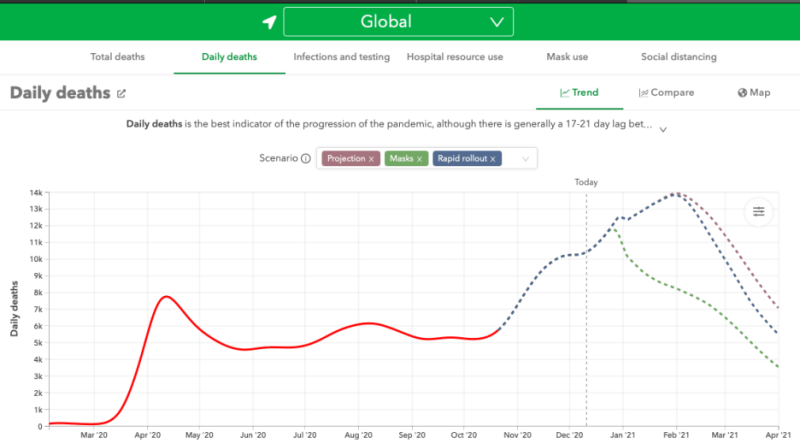 Daily Death Projection assuming three scenarios.
Daily Death Projection assuming three scenarios.It will get much worse before it gets better in February
Projections have worsened for the U.S. and the federal states on my list, expecting a lot more daily deaths before peaking in early February and followed by a steady decrease from then on. The current daily death number for the U.S. minus New York, California and Washington (where this number is ~30% of normal) is as high as the daily average of the last years.
For all countries, the effects of vaccine rollout will be minor in the coming three months and will get more pronounced in the months to follow. See remarks below.
Europe continues to struggle. Even countries that had previously turned the tide are having a hard time keeping the numbers down. The reason is that the virus has infiltrated large parts of the population, including the asymptomatic young, from where it can rapidly spread to people who will get symptoms. This means that even a tiny bit of relaxation of distancing measures will lead to an almost-immediate re-surge of infection numbers. This is very nicely seen in the British numbers.
Germany's daily deaths are predicted to no longer be leading the world by the end of January because they are projected to be eclipsed by deaths in Eastern Europe and Sweden.
Tunisia, which stands as an example for countries with developing economies, has turned the tide but numbers are struggling to come down without the additional push provided by the vaccine. Unfortunately, rich countries seem to have ordered the bulk of the vaccine and poorer ones will have to wait (Tunisia until summer) and fight the virus by distancing measures alone. This will put their economies at an even greater disadvantage.
Brazil's numbers are climbing again and the projections keep pushing the date out by when they will start to decrease. I assume that this failure of accurate prediction stems from the incompleteness of numbers.
| Daily Infections | Daily Deaths | Daily Pos. Rate | R value | January Projection | |
|---|---|---|---|---|---|
| Brazil | 20.5 ↗︎ | 0.304 ↗︎ | ↘︎ ? | ||
| US minus 3 | 71.7 ↑ | 0.982 ↑ | 11.1% ↘︎ | 1.07 → | ↑ |
| California | 72.0 ↑ | 0.376 ↑ | 10.5% ↑ | 1.19 ↘︎ | ⬆︎ |
| Washington | 36.0 ↗︎ | 0.311 ↑ | 13.6% ↑ | 1.13 ↓ | ⬆︎ |
| New York | 50.3 ↑ | 0.419 ↑ | 05.1% ↑ | 1.19 → | ⬆︎ |
| France | 17.6 → | 0.596 → | 06.3% ↓ | 0.83 ↑ | ↗︎ |
| Britain | 25.0 → | 0.608 → | 04.9% → | 0.95 ↗︎ | → |
| Tunisia | 08.2 ↘︎ | 0.383 ↘︎ | 28.1% ↘︎ | → | |
| Sweden | 58.3 ↗︎ | 0.632 ↑ | 13.3% ↑ | ⬆︎ | |
| Germany | 24.6 → | 0.497 ↑ | 10.0% ↗︎ | 1.11 ↗︎ | ⬆︎ |
| New Zealand | 00.0 → | 0.000 → | 00.1% → | → | |
| Rhein-Neckar | 25.7 → | 0.709 ↑ |
The projections by IHME now also include the effect of the vaccine rollout. Their current projection, that is if nothing were changed, assumes a vaccine rollout to full capacity of 90 days. They are comparing this baseline scenario to two other scenarios: a faster vaccine rollout (within 45 days) or more mask wearing (95% of the population) with a 90 day rollout.
I am showing a graph for the global numbers with these three scenarios extrapolated into April and here are my observations:
1. Global daily deaths will spike in early February.
2. By April 2021, daily death numbers will have decreased roughly to the peak levels of April 2020.
3. A faster vaccine rollout would push fatalities 20% lower.
4. Increased mask wearing would push fatalities down 50%.
Hence, the initial effect of a vaccine will be remarkable but still relatively mild (but growing as we move into summer) and far outperformed by stricter social distancing measures and mask wearing.
This also demonstrates the continued need for mask wearing throughout the vaccination period because positive effects of the vaccine will be nullified by easing the distancing measures. This is because a vaccinated person standing between a sick and a healthy person will act like a buffer providing additional "distance" between the latter two.